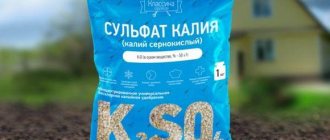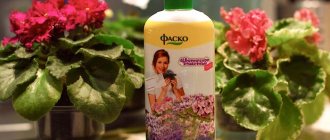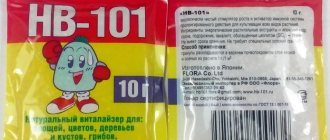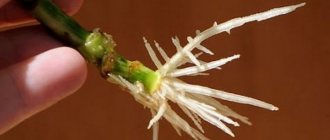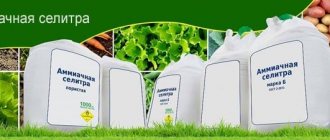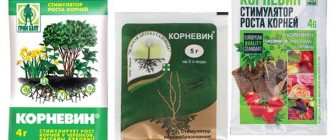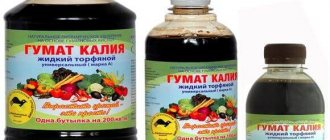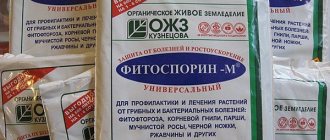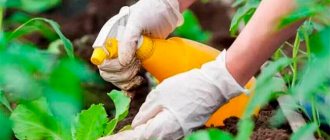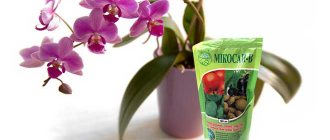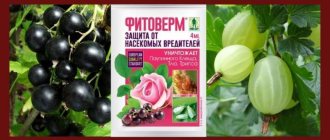45% of chemicals are perfect for caring for gardens, cottages and home flower beds. You just need to know their properties and ability to influence soil and plants. Knowledge about hidden capabilities and methods of application in different areas of human activity will be important.
One of the chemical elements that can affect the improvement of the growth and development of garden crops is magnesium sulfate. Its composition in the form of fertilizer is suitable for both indoor and outdoor flowers.
Reason: the presence of mineral supplements in the complex. The composition of the substance helps restore the plant's immune system. But the use is recommended more for prevention purposes.
Composition and chemical formula
Magnesium sulfate is an inorganic chemical compound. The chemical formula or composition contains only two elements:
- magnesium;
- sulfuric acid.
The production of the substance has been established, since the properties of the powder are universal and are popular in industry, medicine and horticulture. The biological processes that occur with the help of magnesium contribute to the development of tissues and cellular composition in the body of plant and animal origin.
Properties and range of applications:
| Scope of use | Qualities |
| Life | Paper industry. Obtaining refractory material |
| Medicine | Reducing pressure and excessive excitability of the nervous system. Suitable as a choleretic and laxative. Promotes increased diuresis |
| Construction | Covering for airfields and roads. Often added to cement mixture |
Need to know! Absorption by living organisms (plant and animal origin) is better if magnesium is administered with water or food. For flowers and plant crops, it is better to introduce magnesium sulfate into the soil in liquid form.
Area of use
Anhydrous magnesium sulfate is widely used in everyday life and medicine. It also plays a significant role in gardening and gardening. With its help, plants not only develop faster. They make up for the lack of microelements important for life: magnesium by 17%, and sulfur by 13-14%.
Magnesium sulfate replenishes any soil and living organism with two active elements. Accordingly, use will not cause damage to the soil. But the best option for application is acidic, alkaline soil.
Before application, you will need to carry out a number of procedures for better absorption. It is also noted by agricultural experts that fertilizers with magnesium do not pollute the environment and do not produce sediment in the form of pesticides. But they differ from others in that they improve the taste of a vegetable or fruit.
You can purchase the drug at any garden and dacha store. The first on the list of manufacturers of fertilizer mixtures is OJSC Buysky Chemical Plant. The company produces 65% of all fertilizers that gardeners and their “green pets” urgently need.
Buoy fertilizers enjoy positive reviews. They are developed by qualified chemists. Substances quickly adapt. Suitable for drip irrigation, protected and open ground, in greenhouses.
Important role
Magnesium is not one of the main minerals that form the building blocks of plants in the form of phosphates, potassium nitrate and nitrogen compounds. Its place is greater in the list of microelements along with iron, calcium and similar substances from the periodic table.
But green chlorophyll in its structure is nothing more than a magnesium complex. Having caught a photon of light, it is the magnesium ion that triggers a complex chemical reaction with the release of an oxygen molecule into the environment. But not only. What it does is it then allows the plant to grow green mass and form ATP - adenosine triphosphoric acid. Which then directly forms the tissues of ripening grains in cereals, the pulp of fruits in vegetables and fruits.
And working in combination, magnesium and sulfur in the sulfate composition allow the accumulation of ascorbic acid (vitamin C) in fruits.
The sulfate compound MgSO4 is the most easily digestible for plants (if you do not take into account volatile SO2 in the atmosphere. In urgent cases of wilting or stunted growth in plants, you can simultaneously spray and water with magnesium sulfate dissolved in water, in which magnesium and sulfur, respectively, are 16 and 13 %.
Where is it used?
Without the use of magnesium sulfate as a fertilizer, it will not be possible to grow high-energy plant products needed for the production of children's and sports nutrition. As well as medicinal herbal preparations.
And in the production of food additives it is difficult to do without it: the well-known additive E 140 is a specially purified chlorophyll. So not all “E-shki” are equally harmful.
Read: Use of iron chelate for feeding garden and ornamental crops.
The use of magnesia is also useful when growing:
- All types of cabbage.
- Bobovykh.
- Beetroot.
- Garlic and onions - both onions and green varieties.
- Yagod.
- Peppers and eggplant.
- Apples and cherries.
When liming acidic soils with dolomite flour, remember that the content of magnesium in pure form and in the form of sulfates is increased! Therefore, if magnesium compounds are added, it will be necessary to recalculate the amount of this element.
Efficiency for plants
Magnesium sulfate is used quite often for plants as a fertilizer and for prevention. It can be used as an independent substance or in combination with other preparations to improve soil or photosynthesis and development.
The effect that fertilizer has on plants gives them a marketable appearance. That is why, if there is a plot of land of 5 or more hectares, gardeners and farmers choose magnesium sulfate. For people who have a household, it is not necessary to buy a stove heating substance.
It will come from wood ash, which is a combustion waste. Furnace ash contains all the necessary microelements. But there is one “BUT”: magnesium will be enough, but sulfur will have to be added.
Magnesium sulfate for greenhouse tomatoes
In greenhouses, tomatoes often suffer from heat; a sign of a problem will be the leaves curling into a boat shape. Along with normalizing ventilation and shading, plants can be helped by using magnesium sulfate. To do this, prepare a fertilizer solution to which silicon contained in silicate glue or liquid glass is added.
Recipe for preparing the solution:
- take a tablespoon of magnesium sulfate;
- dilute in 1 liter of warm water;
- add a teaspoon of silicate glue;
Mix everything thoroughly, bring the volume to 9 liters with water. The resulting solution is sprayed onto the plants.
This feeding significantly increases the resistance of tomatoes to high temperatures. According to some estimates, plants become able to withstand air temperatures increased by 5–7 °C relative to the standards recommended for tomatoes.
Do not mix silicate solution with fertilizers containing calcium, iron and copper.
How to understand that plants lack magnesium
In gardening, magnesium sulfate is important for all types of plants, including shrubs and trees. But it is advisable to feed them regularly if there is a deficiency of sulfur and magnesium. External signs will help determine the lack of substances. They are similar for both fruit trees and garden crops, flowers (garden, indoor):
- If fruits are present, pay attention to full ripening. If berries, tubers, etc. do not ripen properly or on time, this is evidence of impaired metabolism. Absorption of beneficial microelements is low.
- Examine the leaves from the outside and inside. Changes in color along the edges or in the middle, drying out, wilting of buds, falling leaves - a lack of magnesium, which is at a critical level.
- The leaves can be covered with a pattern that looks like marble. Indicator of decreased chlorophyll production.
If there is insufficient amount of sulfur, these signs are supplemented by: slower growth and discoloration of the green part. This happens gradually.
For what soils is it used?
In a garden with black soil, fertilizers are applied as needed or when the risk of soil dehydration increases. To do this, the feeding procedure is carried out for preventive purposes. But there are types of soil for which magnesium is vital due to its low presence or complete absence.
Mineral fertilizer is always required on sandy and acidic soil. Substances found in these types of soils can harm plants. Reason: high acidity, which prevents magnesium from being absorbed sufficiently.
Security measures
The toxicity of the substance is low, but it is irritating to the skin. Therefore, you must always wear gloves, goggles and a respirator when working with it. Do not remove protective equipment while work is in progress. Try not to let the solution or powder come into contact with your skin. If this happens, rinse immediately with water.
In case of possible poisoning with fertilizer, you need to perform a gastric lavage: drink medicinal charcoal tablets, drink at least 1 liter of water and after 15-20 minutes. induce vomiting.
How to use correctly
The instructions for use of sulfate contain the necessary recommendations for the preparation and use of the substance. The powder is soluble, free-flowing. It is allowed to be administered in mixed form, pure and diluted in water for spraying. Dosages are also indicated for each crop separately.
Preparation of solution and dosage
Magnesium sulfate heptahydrate is easy to dilute. The working fluid has a standard formula: add substances per 10 liters according to the needs of the plant, its condition at the time of application, and take into account the type of soil. The dosage and concentration of the substance is adjusted after studying all the necessary points.
For potatoes
Foliar fertilizing with magnesium for root crops is carried out in dry form. The powder is scattered evenly over the hole. The calculation is made per square meter: from 15 to 20 g. Before planting potatoes in the soil, the substance is also allowed to be added: dosage up to 20 g per square meter. m., then dig up.
Release form
Magnesium sulfate is a complex fertilizer marketed in the form of a white crystalline powder, but a substance with a gray tint is also found. It dissolves easily in water at temperatures from 20°C. Since the composition is low hygroscopic, it can be stored in the air in a place protected from exposure to sunlight and precipitation. The working solution, due to its rapid absorption by the leaves, acts as an ambulance for plants lacking magnesium.
For carrying out agrotechnical measures, fertilizer is produced in the form of kizevit monohydrate – MgSO4 x H2O. If epsomite heptahydrate is used as a nutritional mixture, the dosage specified in the instructions is increased by 1.67 times.
Reviews about the application
Victoria. I used magnesium for pelargoniums. I heard more than once that the mixture helps, so I took a chance. The ornamental plant began to recover quickly. After a detailed study of the instructions, I came to the conclusion: magnesium sulfate is a unique remedy for all types of plants.
Eugene. Magnesium sulfate is definitely beneficial for all types of garden crops. With his help, I became the owner of a magnificent harvest. The quality is superior to even the most expensive goods (vegetables, fruits) in the supermarket.
Compatibility with other drugs
This drug interacts well with other nutritional formulations. Thanks to its working qualities, the chemical composition of garden, vegetable and indoor crops is improved. Root feeding is carried out 2 times per season, which avoids magnesium deficiency in the soil.
Magnesium sulfate is an effective means for increasing the immunity of agricultural plants, including trees and shrubs. This drug significantly improves the taste characteristics of the crop, but it must be used depending on the condition of the plant.
